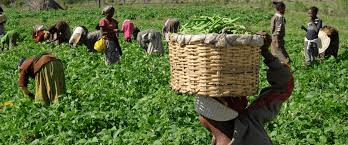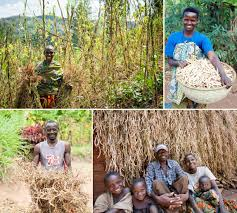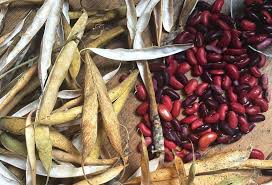Below are the methods of harvesting dry beans:
(1) Estimating Bean Yield
Beans yields can be estimated by knowing the number of seeds per pod, pods per plant and plants per 1/1,000 of an acre. At the time of counting seeds and pods, the maturity status of each should be determined.
If a seed or pods appear not to mature, they shouldn’t be counted. Count the total plants per 1/1,000 acre to complete the data collection. An accurate estimate of plant population per acre can be obtained by counting the number of plants in a length of row equal to 1/1,000 of an acre.
Make at least five counts in separate representative areas of the field, calculate the average of these samples and then multiply this number by 1,000.
Within a representative and uniform plant stand, randomly select five plants each from at least five randomly selected locations in the field. Keeping all plant data separate, pull and count the pods from each plant and then count the seeds to determine average seeds per pod for all five replications. These data are combined with the average number of plants per 1/1,000 acre.
Seeds per pound can vary 10% to 20% for different cultivars within a bean class. If available, use reported estimates for seed number per pound for your cultivar. The accuracy of yield estimates can be improved by counting seeds and pods from at least 10 plants per replication.
(Average seeds per pod) x (average pods per plant) equals average seeds per plant.
(Average seeds per plant) x (plants per 1/1,000 of an acre) x (1,000) divided by seeds per pound of the cultivar equals yield in pounds per acre. Use data in Table 6 for the range in seed weights by class to arrive at seeds per pound if cultivar seeds per pound are unknown.
Read Also: Comprehensive Guide on Dry Beans Production
(2) Harvesting

Bean harvesting is done by one of two ways: undercutting, windrowing and combining from the windrow or straight combining. Beans should be harvested at the 15% to 18% moisture level to minimize splitting and seedcoat damage.
Harvesting at lower moisture levels may result in an excessive percentage of split beans and checked/cracked seedcoats. Beans with damaged seedcoats may split with further handling.
Harvest beans before a killing frost. Frozen immature beans are difficult to separate in processing, while unfrosted immature bean seeds will shrink during drying and can be separated.
Beans are ready for harvest when some of the pods are dry and when the majority of pods have turned yellow. The nearly mature beans in the yellow pods will continue to ripen after they are cut. Too many dry pods at harvest will result in heavy shattering.
Shattering can be reduced by undercutting and windrowing at night or early in the morning when the plants are damp with dew. All bean classes, but especially whites, require a harvest period relatively free from rain to avoid seed discoloration.
(2a) Undercutting and Windrowing
Undercutting and windrowing often are used to harvest Type III and IV (indeterminate) cultivars. Dry beans may be undercut and windrowed in two separate operations or as a single operation.
Blade type undercutters knife the plant root 1 to 2 inches below the soil surface while the bean rod breaks partially cut roots and lifts the plants from the soil.
The number of rows to be placed in one windrow will depend on the density of the crop and the size of the combine used. Leave beans in the windrow only long enough for the lower stem and attached plant parts to dry sufficiently for combining.
Read Also: Health Benefits of Beans and Why you Should Eat Beans
(2b) Direct Harvesting

Bush type beans may be harvested with a straight-cut attachment on a combine. Combines equipped with flexible cutter bars and pickup reels operate much closer to the soil and save more seed, compared with a conventional grain table. Most field losses are caused by pods being cut by the cutter bar or the cutter bar operating at an incorrect speed.
Previous equipment developments include replacing or supplementing the pickup reel with an air reel to help move plants across the cutter bar. Research has shown that field losses with conventional straight-cut type headers can range from 20% to 40% of the yield.
Grower experiences with direct-cut headers suggest that the addition of an air reel and supplemental lifter guards to a flexible cutter bar can reduce loss to 5% to 15% of the total yield.
Direct harvest reduces equipment investment, harvest time and operational costs but is associated with reduced seed yield and quality. Direct harvesting is common for navy and black beans, due to their upright architecture. Direct harvest is also used with some pinto and great northern cultivars due to improved upright architecture.
Field surveys at harvest time were conducted across three counties in the Devils Lake region in North Dakota. The average seed loss was higher for direct harvesting than for the conventional method (undercut and windrowed prior to combining) mainly due to a larger seed and pod loss measured in the area between combine harvest swaths, indicating losses occurred at the cutter bar.
The best three conventional harvested fields averaged 24 pounds per acre (lb/acre) of harvest loss, while the three worst fields averaged 219 lb/acre of harvest loss. The best three direct-harvested fields averaged 101 lb/acre of harvest loss, while the three worst fields averaged 347 lb/acre of harvest loss.
These surveys suggest that the loss can be lowered significantly by improving management conditions, especially at harvest (equipment setup and operator care).
Experiments were conducted (Carrington Prosper and Hatton, N.D.) to evaluate the effect of seed yield and market class (pinto, navy and black) on the most commonly grown cultivars in North Dakota and Minnesota under conditions of conventional and direct harvest.
Harvest method and cultivar were consistently the most important factors contributing to seed yield and yield loss in this study.
As expected, the seed loss was significantly higher under direct harvest. Under conventional harvesting, no difference occurred in seed yield among cultivars within market class.
However, under direct harvest, from three tested cultivars per market class, the cultivars Lariat (pinto), T-39 and Eclipse (black) and Vista (navy) showed the lowest yield loss when compared with the other cultivars within the same market class.
This research emphasized the important role of cultivar and environmental conditions at harvest time in determining the seed yield under direct harvest. Cultivar selection should not be based only on yield potential but also on architectural attributes leading to a minimal yield loss if the direct-harvest method is used.
Growers need to consider the cultivar to be planted, environmental conditions, moisture content of the beans at harvest, adjustments to the equipment and operator skill when deciding on the harvest method to use.
Read Also: Soybeans: it’s Importance and Health Benefits
(2c) Combine Operation

Grain combines frequently are used for harvesting beans, but growers with large acreages often use special bean combines. These usually have two cylinders specifically designed for bean threshing and special separating and cleaning units. These special combines do not contain augers and usually move beans with conveyor belts or bucket elevators.
Conventional combines with rasp-bar cylinders work well for beans. Rotary-cylinder combines also work well, causing less damage to seed. Rotary combines should be equipped with special dry bean rotors and the appropriate threshing bar configuration to provide optimum threshing and separation.
Combining should begin when beans reach 18% moisture content. Combine cylinders should be operated initially at a speed as recommended in the operators manual and then adjusted on a regular basis as conditions change. Some machines may need special speed reducers to obtain proper speed.
Cylinder speeds will vary among combines because diameters of cylinders and rotors vary from 17 inches up to 30 inches or more. Setting the cylinder speed as slow as possible and checking to be sure that pods are threshed to allow bean removal usually is best. Excessive cylinder speeds will cause excessive splits and checking.
Reducing the cylinder speed as the day progresses is necessary to compensate for additional drying. Also, as beans dry down, the distance between cylinder or rotor to concave should be increased. Check the operators manual for recommended cylinder speed and concave settings and then adjust accordingly.
Harvesting only during the morning and evening when the pods are tough may be necessary to hold shattering losses to a minimum and reduce the number of split beans and damaged seedcoats. Feed the combine cylinder to near maximum capacity without overloading.
Use a faster travel speed or put more rows in the windrow to maintain feeding of the combine to full capacity. The additional residue going through the threshing mechanism will cushion the beans and reduce damage.
Set the adjustable chaffer at 5/8 inch and the sieve at 7/16 inch. This should allow the threshed beans and some pods to fall through the chaffer, and the cleaning sieve will allow only threshed beans to fall through to the grain auger.
Use a relatively high fan speed and direct the blast toward the forward one-third of the cleaning shoe because crop density is the same as it is for wheat. Check the operators manual for specific recommendations.
Check the tailings return periodically to note the quantity and composition of the material being returned to the cylinder for rethreshing. Threshed beans in the tailing return indicate that the adjustable chaffer is set too tightly.
Completely threshed beans returning through the auger for rethreshing generally increases the amount of split beans and checked seedcoats.
Look in the grain tank for dirt and foreign material and for beans that are split or have damaged seedcoats. Excess dirt and chaff generally indicate that the adjustable sieve is adjusted too widely or that the fan blast is inadequate or improperly directed.
Read Also: Irrigation and Water Use for Dry Beans
Excessive seedcoat checks and splits generally indicate one or more of the following:
• The cylinder speed is too high.
• The cylinder/rotor to concave clearance is too small.
• Too many concave filler bars or grates are being used.
• Too many completely threshed beans are being returned through the tailings system.
Most combine manufacturers have a number of optional accessories available for use on beans. These usually are bean sieves, or screens placed in the grain pan and along elevator tubes. These help remove dirt and foreign material from the beans.
Always handle dry beans gently. Avoid dropping beans from great heights in unloading and handling. Bean seed checks and cracks when dropped, particularly on hard surfaces, when it is dry.
Cushion or deflect the fall of beans whenever possible. Keep elevator flight chains snug so that flights do not ride on beans.
(3) Measurement of Harvest Loss
Measuring field loss during harvest is relatively easy. Five simple steps can provide a good harvest loss estimate:
1. Locate three random sites in the field.
2. At each site, outline an area that is 1 foot in the direction of equipment travel and is as wide as the effective width of the implement. For example, if a combine is picking up windrows containing 12 30-inch rows, the width of the measurement area should be 30 feet.
Examine the entire width of the implement pass, not just behind the threshing section of the combine, where loss can be concentrated.
3. Search the soil surface and through any soil loosened by harvest implements within the outlined area for seeds and unthreshed pods. Count all bean seeds.
Read Also: Guide on How to Grow Tomatoes
4. Divide the number of seeds found by the number of square feet within the outlined area. This will provide the average number of bean seeds lost per square foot. Take an average of the three areas sampled within the field.
5. Use Table 22 to convert the average number of seeds lost per square foot to pounds of seed lost per acre for specific seed sizes.
For example, if a sampled area over the full effective width of an implement pass averaged one pinto bean seed per square foot, the field loss would be approximately 36 lb/acre, assuming 1,200 seeds/lb.
To estimate the seed loss for three seeds/square foot for the same seed size of 1,200 seeds/lb, multiply 3 seeds by 1 by 36 lb/acre = 108 lb/acre field loss.
Another method that is easier but not as accurate is to take a 1-square-foot frame, randomly lay it on the ground and count the seeds inside the frame. If you do this at four or five places in the field, you will get a good estimate of seed loss.
Do some loss counts at places away from directly behind the combine as well as behind the combine. Making all counts directly behind the combine will give an excessively high seed loss count.
Multiply the average number of seeds lost per square foot x 43,560 (square feet per acre) and divide by the number of seeds per pound.
Read Also: 12 Management Tips for better Poultry Performance Potential
Frequently Asked Questions
We will update this section soon.

